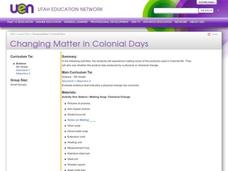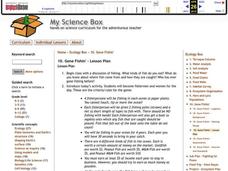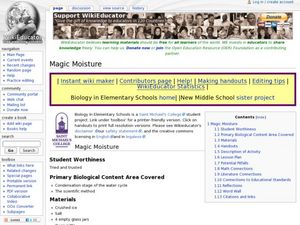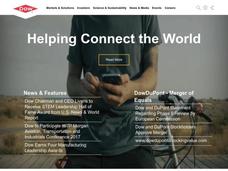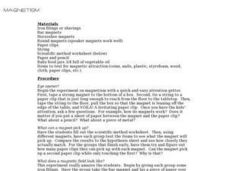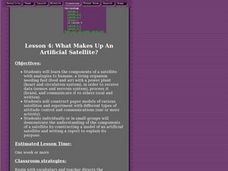Curated OER
Making Plastic
Students experiment to create a plastic solution. In this science lesson plan, students use sodium borax and polyvinyl alcohol to create their solution, then identify, discuss, and chart observations on the end product.
Curated OER
Colonial Life
Fifth graders explore American colonial life. In this interdisciplinary history and science lesson, 5th graders participate in several hands-on activities that require them to make colonial products that involve physical or chemical...
Curated OER
Gone Fishin'
Students experiment with population management in this hands-on lesson. In this biology lesson, students collect data on overuse of a resource and how to manage for sustainability. Students fish for m&m's using straws and try to...
Curated OER
Farming in Space
Eighth graders examine the ways that NASA could create space farms, In this space farms lesson students complete an experiment where they grow several plants.
Curated OER
Magic Moisture
Young scholars discover the process of condensation. In this experimental lesson, students hypothesize and conduct an experiment to determine where the water comes from during condensation.
Curated OER
No Impact Project: Water
Students use the "No Impact Project" to analyze the consumption of water. In this water consumption lesson, students discuss the pros and cons of tap water or bottled water. Students read about chemicals in water and watch a video clip...
Curated OER
Straw Chromatography
High schoolers separate food coloring using liquid chromatography. For this chemistry lesson, students explain the effects of different solvents on the rate of separation.
Curated OER
Is There A Fungus Among Us?
Students experiment with fungi and yeast in order to determine their role in nature. Students study terms associated with fungi and yeast through this series of lessons.
Curated OER
Magnetism and the Scientific method
Students explore magnets and magnetic Fields. They experiment with various objects to determine which will be attracted to the magnet. Their results are recorded in a scientific method worksheet.
Curated OER
What Makes Up An Artificial Satellite?
Students discover the components of a satellite using analogies to humans in a class discussion and participate in an activity in which they construct a paper model of a satellites and experiment with different types of attitude control...
Curated OER
Toothpick Worms
Students investigate camouflage. In this science lesson plan, students experience the role of color in camouflage as they complete a hands-on activity.
Curated OER
Shake, Rattle and Roll
Students compare the weathering of materials. in this weathering lesson, students experiment with the chemical and physical weathering of different materials. Students use salt and water as an example of how weathering occurs.
Curated OER
Baleen Whales vs. Toothed Whales
Second graders review mammal characteristics and study two types of whales. In this mammal study lesson, 2nd graders discuss mammals and define their five characteristics. Students complete a whale worksheet and define differences...
Curated OER
Understanding the Epidemiologic Triangle through Infectious Disease
Students examine the epidemiologic triangle. In this disease lesson, students discuss infectious disease as they study how they spread and discover their families' experiences with them. Students research Internet sites to complete...
Curated OER
Baby Peanut Plants
Science is a subject ripe with opportunities to read informational text. Kids read to learn about peanuts! They read an informational passage, fill out two comprehension worksheets, and then conduct a lab experiment on a peanut. The...
Curated OER
Three Clouds Activity
Learners explore how clouds are produced through three different age-appropriate hands-on experiments.
Curated OER
Smoothing Out the Rough Spots
Fifth graders experiment to observe the changes created on a surface by mechanical action of water with varying amounts of mineral content and abrasive qualities. They write the predictions of their outcomes and describe all of their...
Curated OER
Photosynthesis: Intake of Carbon Dioxide - Production of Oxygen
Students, after a long-term observation of photosynthesis with aquatic plants, assess the benefits of photosynthesis towards all living organisms. They explain in their own words the two cycles within photosynthesis. Guided discussion...
Curated OER
The Shape of Things
Students study the natural incubation of hens and the important characteristics of the egg shell. They perform experiments to test the strength of the dome shape of an egg and prove that an eggshell has pores to allow air to pass. ...
Curated OER
Radical Raptors
Students define raptor, explain why raptors are important, describe unique physical characteristics of various types of raptors, and explain life cycle of raptors. Students then play Habitat Game, describe food and hunting habits of...
Curated OER
Cats
Students participate in an after school program that promotes communication with others, solving problems, and making decisions. They experience getting in touch with themselves, about cats, training cats, showing cats and explore...
Curated OER
Chemical and Physical Changes
Young scholars experiment, identify and apply the concepts of chemical and physical changes utilizing real-world examples. They discuss and model physical and chemical changes, answer guided questions and play a game that reinforces the...
Curated OER
The Investigation Of The Taste Buds
Young scholars explore the sense of taste. In this biology lesson plan, students investigate the sense of tastes as they experience salty, sour, bitter, and sweet tastes. Young scholars then discover how taste buds do their job.
Curated OER
Capillary Action Dip N' Dye
Learners complete an experiment to observe capillary action. In this capillary action lesson, students add food coloring to a bowl and watch what happens as they dip the corner of the paper in it. Learners observe the results.



